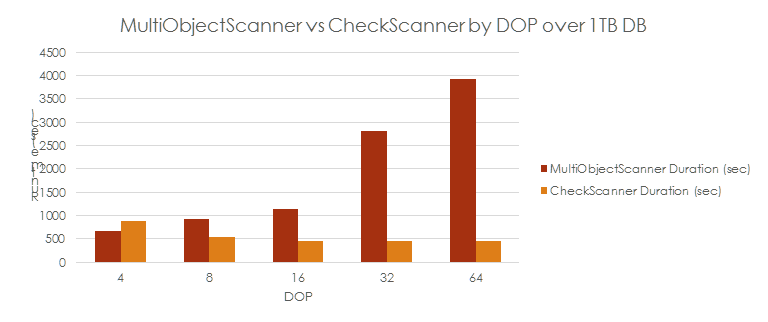Note
Access to this page requires authorization. You can try signing in or changing directories.
Access to this page requires authorization. You can try changing directories.
Many of you have experienced (MULTI_OBJECT_SCANNER* based) waits while running DBCC CHECKS*(checkdb, checktable, …)
Internally DBCC CHECK* uses a page scanning coordinator design (MultiObjectScanner.) SQL Server 2016 changes the internal design to (CheckScanner), applying no lock semantics and a design similar to those used with In-Memory Optimized (Hekaton) objects, allowing DBCC operations to scale far better than previous releases.
The following chart shows the same 1TB database testing.
- MultiObjectScanner = Older design
- CheckScanner = New design
The visual is powerful, showing the older design does not scale and with more than 8 DOP CPUs, significant negative scaling occurs while the new design provides far better results.
Note: In addition to the no lock semantics the CheckScanner leverages advanced read-ahead capabilities. The same read-ahead advancements are included in parallel scans of a heap.
'It Just Runs Faster' - Out of the box SQL Server 2016 DBCC provides you better performance, scale while shrinking your maintenance window(s.)
Ryan Stonecipher - Principle SQL Server Software Engineer
Bob Dorr - Principal SQL Server Escalation Engineer
DEMO - It Just Runs: DBCC CheckDB
Overview
The DBCC CheckDB demonstration loads a table and demonstrates the performance improvement.
Steps
- Use SQL Server Management Studio (SSMS) or your favorite query editor to connect to a SQL Server 2012 or 2014 instance.
- Paste the script below in a new query window
- Execute (ATL+X) the script and take note of the elapsed execution time.
On the same hardware/machine repeat steps 1 thru 3 using an instance of SQL Server 2016 CTP 3.0 or newer release.
Note: You may need to execute the dbcc a second time so buffer cache is hot, eliminating I/O sub-system variants.
Actual Scenarios
SQL Server 2016 has been vetted by a wide range of customers. The positive impact of these changes has been realized by:
- Every customer can reduce their maintenance window because of the DBCC performance improvements
- A World Wide Shipping company using was able to reduce their maintenance window from 20 hours to 5 using SQL Server 2016.
- Significant reduction in the maintenance window for the world's largest ERP provider.
Sample Results (7 times faster)
Machine |
32GB RAM, 4 Core Hyper-threaded enabled 2.8Ghz, SSD Storage |
SQL Server |
Out of the box, default installation |
SQL Server 2014 |
12880ms |
SQL Server 2016 |
1676ms |
--------------------------------------
-- Demonstration showing performance of CheckDB
--------------------------------------
use tempdb
go
set nocount on
go
if(0 <> (select count(*) from tempdb.sys.objects where name = 'tblDBCC') )
begin
drop table tblDBCC
end
go
create table tblDBCC
(
iID int NOT NULL IDENTITY(1,1) PRIMARY KEY CLUSTERED,
strData nvarchar(2000) NOT NULL
)
go
-- Insert data to expand to a table that allows DOP activities
print 'Populating Data'
go
begin tran
go
insert into tblDBCC (strData) values ( replicate(N'X', 2000) )
while(SCOPE_IDENTITY() < 100000)
begin
insert into tblDBCC (strData) values ( replicate(N'X', 2000) )
end
go
commit tran
go
--------------------------------------
-- CheckDB
--------------------------------------
declare @dtStart datetime
set @dtStart = GETUTCDATE();
dbcc checkdb(tempdb)
select datediff(ms, @dtStart, GetUTCDate()) as [Elapsed DBCC checkdb (ms)]
go
Comments
- Anonymous
August 13, 2016
WOW !!! - Anonymous
February 15, 2017
So it is now slower for 4 cores, so that it can be a lot faster on more expensive systems..... (Therefore if a company is just starting up and does not have much money, SQL Server is no longer aimed at them.....)- Anonymous
February 15, 2017
Sorry for any confusion. It is not 4 'CORES' but CPUs and the difference is minimal so SQL can meet your needs across a wide variety of hardware.
- Anonymous
